by scott.gillum | Oct 27, 2013 | 2013, Marketing
What company do customers feel most connected to emotionally?
Apple? Nope. Amazon? Sorry. It must be Nordstrom’s then, right? Not even close. To find the company that has the strongest emotional connection with customers, you have to leave the consumer world behind. Blows your mind, doesn’t it.
According to new research from Google and the CEB, customers are more emotionally connected to B2B brands, and it’s not even close. The company customers say that they are most emotionally connect to is…Cisco.
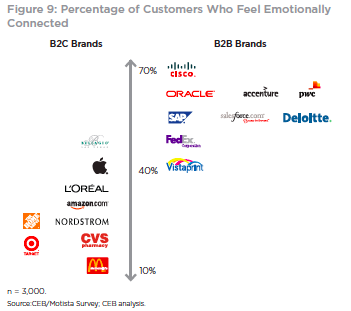
Why? Well, it’s about understanding risk. The more risk involved with a purchase decision, the higher the likelihood of an emotional connection. Increase the variables related to risk (e.g. losing a job, wasting corporate investments) and you have the ingredients for an emotionally involved buyer. Personal risks peak when others are counting on you to make the right decision and the stakes are highest.
How did Cisco become number 1? It has to do with Cisco’s ability to reduce risk with buyers. Forrester ‘s Evaluate Your Channel Partner Loyalty Program, surveyed over 250 hi-tech business partners to understand the drivers of loyalty. Partners were asked to select the reason/s “why their most strategic vendor is their most important vendor” (see the table below).
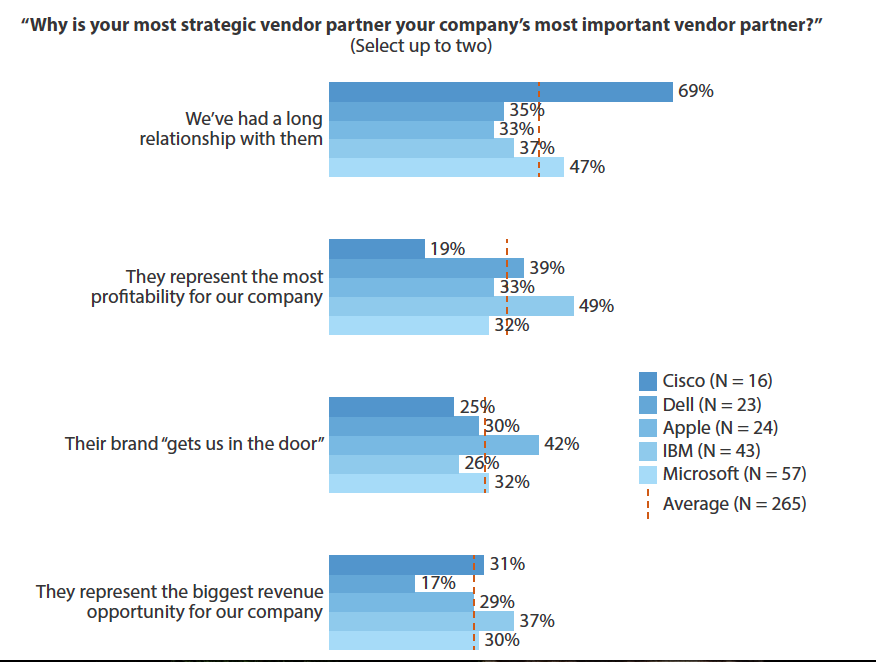 Partners, buyers of Cisco gear, selected Cisco for the strength of the relationship, despite that fact that Cisco was also the most profitable vendor (established earlier in the research). Cisco partners value the relationship more highly than other partners, 26% more.
Partners, buyers of Cisco gear, selected Cisco for the strength of the relationship, despite that fact that Cisco was also the most profitable vendor (established earlier in the research). Cisco partners value the relationship more highly than other partners, 26% more.
The reason is related to how Cisco is able to create and communicate what the CEB and Google research describes as “personal value” consisting of four parts; professional, social, emotional and self-image benefits. Some of which are communicated, others realized through the customer experience. For example, existing customers understand the “personal value” associated with an existing vendor 2X that of non-customers.
Cisco has built a strong “personal value” equation by investing heavily in their partner’s success. It supports them professionally through training and certification programs. Invest in the brand to support the emotional bond and self-image, and in sales and marketing activities to drive demand.
All of which reduces the risk associate with failure, be it personally or professionally. And in return, they trust Cisco with their livelihood, valuing the “Relationship” above rational drivers, like profits and revenue.
Getting Personal and Emotional
How can we leverage this insight? To start, focus on better communicating “personal value” to non-customers. The research found that brand messaging connects with buyers early on, but the excitement wanes over time as we move down the buyer journey into the evaluation phases.
The rational brain takes over to assess risk, and the complications associated with the purchase, at this point as much as 50% of the potential deals stall or fall out of the process. Risk impacts their initial positive emotions, and unfortunately, we don’t much to help them.
To counter those feelings engage them with personal-value messaging, go beyond just using feature/functionality language (functional benefits) to describe products or services by combining the emotional and self-expressive benefits as well (see below).
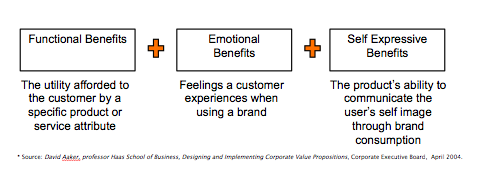
Like Cisco, understand how your products or services impact buyers. Does it make them feel “smarter” by having the latest technology, or more “secure” in their role. Although buyers are individuals with unique personalities, and should be treated that way, they most likely share the same fears, uncertainties, and doubts we have in our roles.
Get to know them, like you know yourself. Stop assume they are always rational and buy on price and/or functionality. And finally, realize that there are customers who are emotionally connected to your brand, and/or highly value their relationship with your organization, and when they say that they “love your product or company”…they actually might just mean it.
by scott.gillum | Sep 22, 2013 | 2013, Marketing
Do you think the senior executive team is excited about the big lead generation campaign you just launched? Nope. How about the number of “Likes” on your corporate Facebook page? Think again. Marketing doesn’t matter in many organizations, because it thinks, operates, and worst of all, reports “small.”
Executives sitting in the “C-suite” got there by thinking big, managing big, and reporting “big”. Marketers commit hari-kari with this group by reporting tactical level activities – “minutia,” that garners no ones attention. Do you think the head of sales is reporting the number of sales calls reps make a day? No. If you want to get their attention, you have to make marketing more important to them. Here are five ways to go “Big.”
- Big Bets – if you want marketing to be valued you have to understand, and link, to what the organization values. It’s that simple. If it’s market share, connect marketing objectives and activities to acquisition or/and account penetration. If it’s profit, understand the drivers and align your teams’ efforts appropriately.
- Big Strategy – once you understand how to link marketing to the business objectives your job is then to connect those big bets to day-to-day marketing activities. Your smarts will be needed to take the marketing requirements from the product and sales organizations (which may be very tactical) and link them to the overall marketing strategy that aligns to the “big bets.” Warning – this will require math, perhaps lots of it.
- Big Plays – to execute, organize your marketing objectives as defined by your internal stakeholders into 2 or 3 “big plays.” If market share is a key growth objective, a big play should focus on an area that has the greatest opportunity to do that…a specific market, product and customer. All marketing activities/campaigns should be nested around that “play.’ Messaging is critical here because it is the “big play” wrapper that creates consistency in the communication across execution –think “Smarter Planet.” IBM discovered years ago that the best performing campaigns stayed in market the longest, and had the highest level of integrated tactics. It takes focus and discipline to do, but if you can get there it will make your life easier by allowing you to organize everything under a big play umbrella, and if things don’t fit…then maybe you don’t do it.
- Big Results – the first rule here is to understand that measurement and reporting are different. Measure everything, but only report “process” or “results” metrics. Executives care about “outputs,” not “inputs.” Inputs are activities, outputs are results, know the difference.
- Big Balls – ya gotta have ‘em. You are going to have to get comfortable with, and embrace risk. If you do this right, you will be placing bets, that at the time, you will not know how, or if, they are going to pay off. Years ago, I worked with a CEO that committed to double the size of the business in three years. The CMO calculating sales cycles realized to support that growth marketing needed to double the number of leads that year. She had no idea how she was going to do it, but it caught the attention of the senior management team, focused her team, and it happened. But as she learned, you don’t try to go it alone. Reach out to others with your plan, get their buy-in and support. Level set expectations on timing and performance, it may require a significant investment in time and money for the “big bets” to pay off. Set big goals, but be realistic in getting there.
The time for going “big” is now. In Forrester’s recent B2B CMO’s Must Evolve or Move On report, 97% of marketing leaders who were survey agree with the statement that “Marketing must do things that is has never do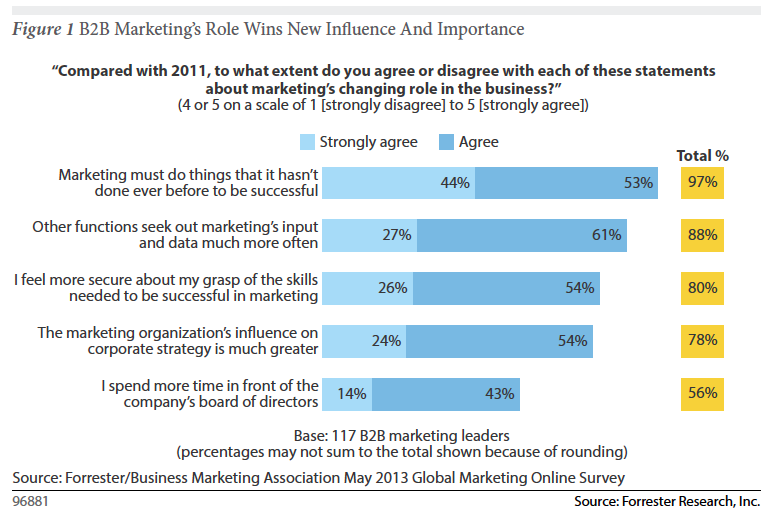 ne before to be successful.”
ne before to be successful.”
The other interesting, and important nugget from the research is that marketing is playing a bigger role in influencing corporate strategy, and other functions. Make sure you’re capturing this opportunity at your organization by thinking, and by being — “Big”.
by scott.gillum | Jul 2, 2013 | 2013, Marketing
A week doesn’t go by that I don’t hear clients express concern about their ability to produce a consistent flow of quality content, yet every day my inbox is full of emails offering white papers, research, webcasts and blog posts.
So we set out to solve this “paradox of content marketing.” How is it that clients are not able to produce quality content for their purposes, but I get an average of 35 emails a day offering me content?
Our Approach
With the help of our summer intern, Sergio Pianko from Georgetown, I archived a weeks worth of content related emails sent to my primary work email. For this experiment, I did not include any other personal email accounts, social media or offline publications.
The Findings
Content Volume
For the week, I received 217 unique emails containing access to 1,131 pieces of content. Thursday was the peak day of the week, which surprised me, with 9 am being the peak time of day, which didn’t. I received an email offering me content, on average, almost every 15 minutes.

Content Type
A new report by the CMO Council entitled Better Lead Yield in the Content Marketing Field found that 87% of the respondents said that online content plays a major or moderate role in influencing vendor selection. The content they trust and value most? Professional association research and whitepapers 67%, industry research reports and whitepapers and customer case studies. The least valuable was vendor content, with 67% saying they don’t trust it.
What’s in my inbox? Well, I’m partial to content aggregators. My two favorites providers are MediaPost because of their ability to narrow the scope on relevant topics, and their expansive content producers (including this author). I also like SmartBrief publications, they provide e-newsletters on behalf of others, like the BMA. I find the layout to be quick and easy to peruse, and they usually feature a research offer.
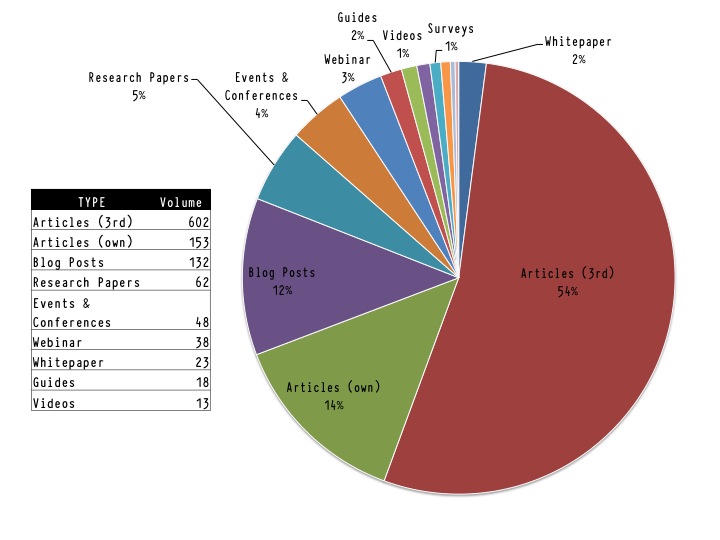
It was interesting to see that even though White Papers were mentioned to be the most valuable content piece according to B2B buyers, it represented less than 2% of the content I received.
Key Insights
Stop Calling Me
Downloading content that you offer for free does not make me a prospect. Save the $25 dollars you’re spending on the outbound telemarketing call and use it to track my behavior until I am qualified. Still not enough for you, we get that “free” comes with a price so consider this payment. According to the CMO Council report 87% of B2B buyers share your content with 5 or more people. Remarkably, 28% mentioned that they share it with more than 100 folks.
Overweight Content related to the Business Case
The first phase of the buyer journey is research. A prospect can cycle in this phase for weeks, even months, never reaching the next step, which is the business case. If you want to qualify real prospect, focus on providing them content that is related to making a business case for buying your product or service. For lead nurturing, overweight the scoring for pages or content that relate to this as well.
Content is not King, nor is Relevancy, Actionable is the Opportunity
Sergio sorted the content using four filters; Relevancy, Usefulness, Credibility, and Actionable, based on the definition in the chart (below). For the most part, I had selected information sources that produce relevant content, and because of my use of aggregators it kept me informed about industry develops or issues relating to my clients. We then check into the backgrounds of the content authors and found that for the most part, they were credible using our definition (below). But along the way Sergio did discover a couple of frauds, not surprisingly in the social media space.
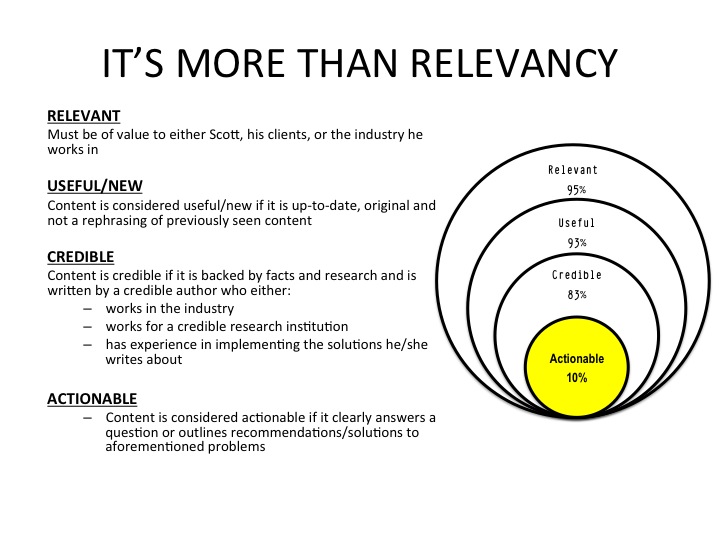
The most interesting findings was that very little (less than 10%) of the content was “actionable” in that it provided recommendation/s or solutions to the problem or issue discussed. And most of the actionable content came in the form of Webcasts. As a content marketer this is the opportunity and, given its value, think strategically about how you deliver it. Because of the scarcity of this type of information, you can request an exchange of value with the audience, be it contact information, attendance at a webcast, etc.
Opportunity #2 – Video
Numerous studies have pointed to the growing influence and use of video content. Yet it represented only 1% of the content I was offered. Yes, it is more complex, time consuming and expensive but it will also drive better results. It’s worth exploring, from past experience early innovators reap the greatest rewards.
Develop Buyer Personas
To understand some of the findings it may be helpful to know my email and content profile. I am an active content seeker and email deleter. Unlike some colleagues and friends, I like to keep a neat and tidy inbox. I delete emails early in the morning, and late afternoons. During the day I may delete emails as previews flash on the screen. Also, because of my consulting background, I am drawn to market research and data oriented content. I download and archive many items that I later review…typically on planes.
That’s my content “persona.” Agencies have been creating audience personas for years and now, if you’re a client side marketers, it’s your turn. According to the Demand Gen Blueprint survey only 25% of marketers have developed buyer personas, and of those who have, only 35% have mapped content to buyer stages.
Who Does it Best?
To win, you have to make it in the inbox, get the email open and the content viewed. The organization that does that best, in this man’s opinion, is IBM. For their insight into the C-Suite, quality of research, and frequency of contact…which is only when they have something of value. They are the only “vendor” I let in my inbox.
Runner up is McKinsey, for their “big picture” thinking and ability to take complex problems and explain them in very simple terms (especially in 2 min videos). Best New “Up and Comer” is the Aberdeen Group, a recent change in their business model allows free access to quality research, which this “freegan” appreciates.
Content marketing will only grow in importance for business marketers over the next few years. There are opportunities to get your information viewed, and shared, but to accomplish that you have to understand your audience’s content consumption behavior, provide them something of value, and deliver it in the channel and/or through the content provider they prefer.
There is a lot of work to be done, so have at it. Looking for a starting point, do a similar experiment with your customers. Ask them to send you a weeks worth of content related emails, you’ll be surprised by what you find.
by scott.gillum | Jun 10, 2013 | 2013, Marketing
 This time of year, America’s third or fourth (depending on where you live) most popular sport gets its moment in the sun. The Stanley Cup finals begin this week and the nation’s attention turns to ice, hockey sticks, pucks, and maybe mullets.
This time of year, America’s third or fourth (depending on where you live) most popular sport gets its moment in the sun. The Stanley Cup finals begin this week and the nation’s attention turns to ice, hockey sticks, pucks, and maybe mullets.
For business marketers, the “holy grail,” or in this case the “Stanley Cup,” has been trying to demonstrate the business impact of social media. Not defined by adoption, usage, or engagement, but by influence. Proving that social media and/or social networks can influence buyer behavior. New insight suggests that it might be time to lace up the skates and put on the pads.
Word of mouth (WOM), defined by person-to-person communication be that in person or over the phone, is and has always been the most used, and most influential channel for business buyers. Sometimes also described and measured as NPS (Net Promoter Score), it is the “Wayne Gretsky” of driving influence among decision makers, both in new acquisition, and for renewal.
Unlike WOM, Social Media has struggled with demonstrating influence. Adoption and usage rates continue to grow, but the impact on B2B decision makers has been difficult to nearly impossible to measure (btw – this is not unlike other, more established media channels).
That was until now. Research from Buyersphere may give us a clue to how social media may influence decision makers in the near future, and it has given us a couple of “hockey sticks” and a “puck” to play with.
According to Buyersphere’s Annual Survey of B2B Buyer Behavior, even though buyers mention social media (and providers such as Twitter, Facebook and Linkedin) when asked to rate their usage and the usefulness of channels when searching for vendors, they fall off the grid when asked to evaluate their influence. As you would expect, word of mouth came out on top.
Diving deeper into the research, it revealed a few game changing findings. Twenty to thirty year olds (Gen Y), act like no other previous generations. The first “hockey stick” is somewhat known — twenty-something business buyers are roughly twice as likely to seek information or advice from social media as the generation before them (31-40 year olds). And almost four times more likely to than the baby boomers (51-60 year olds).
 The second hockey stick, and the one that may end up being somewhat problematic for marketers, is that 49% of Millennials stated that they wanted to create and publish their own professional content. They not only want your content, but they also want to be able to disassemble it and repackage it with their own point of view.
The second hockey stick, and the one that may end up being somewhat problematic for marketers, is that 49% of Millennials stated that they wanted to create and publish their own professional content. They not only want your content, but they also want to be able to disassemble it and repackage it with their own point of view.
And finally, the puck to play with is that buyers under 30 are the only group that describe word of mouth as social media first, and then phone or in person. Close to 50% of Gen Y buyers defined WOM as any social media, in person or phone, mentioned by only 33% of the respondents. Buyers 40-50 by contrast, define WOM as in person or phone 60% of the time with any social media platform only 23%.
Game On
Marketers most powerful and influential channel is now being redefined, and this presents the best opportunity to date to demonstrate the impact of social media on buyer behavior. “To skate to where the puck is going to be” as Gresky used to say, we need to plan now.
To define the approach we need to understand the components of “social media” that are often lumped together – social networks and social media. Social networks refer to the connection among users and their social structure (friend, business acquaintance, etc.).
Social media is defined as the online channel used to generate, access and distribute content. The distinction is important because of the way different generations of business buyers use and value them. This is key to unlocking influence.
We know that their social network heavily influences Gen Y, more than any other generation. We know that half of them want to produce and share their own content, 60% upload content to the web, and 62% rate products and services on the web.
So for Enterprise accounts, where Gen Y is 5-10 years from occupying the C-Suite, take a lesson from McDonalds and “grow your own customers.” Get Gen Y hooked on your content by involving them in your brand and making your content modular so it’s easy to repackage and share. The route to influence is through cause marketing efforts delivered via mobile devices. Thirty-seven percent of Millennials say they are drawn to products with co-branded campaigns.
For small businesses, which Gen Y owns close to 1 out of 3, according to the Executive Council of Small Business (ECSB), the goal should be to make them advocate for your brand, product or services to their network. To do that, focus on issue resolution, the number one loyalty driver. For prospects, provide them with information that is useful.
According to the ECSB, the number one pain point for all small business owners is sales and customer acquisition; being twice as prevalent among Gen Y owners. Specifically, lead generation and successfully competing with other small business owners. Help them understand how your products and services can help them grow their business.
Even though there is potential for social media to deliver a real, tangible business impact, it will be similar to this championship series. It’s not going to be quick, expect to lose a game or two along the way, and to be successful you’ll need to take many shots on goal…hell, you may even lose a tooth or get a “shiner.”
by scott.gillum | Feb 19, 2013 | 2013, Marketing
You know the question is coming, because it comes every year. You know who is going to ask it, because they ask it every year. It’s just a matter of when, perhaps at the end of a difficult quarter, or during a mid-year review meeting. As budgets are being discussed it comes; “What are we getting from our marketing dollars?”
It’s a fair question to ask, and given the size of some marketing budgets, marketers should be asking the same question. To answer the sales executive (usually the one asking the question) you must first recognize what they are really asking, which is; “what is the value of marketing to them?” Specifically, they want to know the impact marketing is having on sales performance, beyond leads.
A few years ago, we did some interesting research for a medical equipment manufacturer. Their analysis showed that they were missing opportunities but they couldn’t agree on why – was it a sales or marketing issue?
To uncover the answer we interviewed hundreds of buyers (customers and prospects) in order to rate the performance of the company compared to three competitors, at four stages of the pipeline, product awareness (unaided), consideration, proposal and win. We then constructed a quantitative model to reflect the impact of changes in performance. Two years later, we were given a unique opportunity to measure the impact of recommendations and investments.
The research yielded three key insights on the importance of marketing and how it was impacting their sales success:
1. Increasing Opportunities – without marketing support sales cannot move consideration rates. The company’s unaided product awareness rate was 62%, compared to 88% for the market share leader. The consideration rate was even worse at 46% compared to 86% for the leading competitor.
The organization had a strong sales culture. So to demonstrate the need to increase marketing activity, and not just sales coverage, we included “relationship with the sales team” as a key consideration drive, along with typical drivers such as; price, brand, and service.
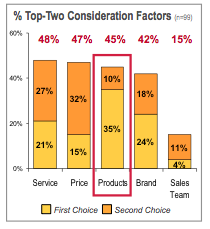
The research showed that the relationship with the sales team was not an important consideration driver. In fact, the data revealed that reps could do very little to change buyers’ perceptions relating to products and service. It also revealed a new buyer that was not being reached by the sales force.
The company increased the marketing budget and reallocated funds from events into digital marketing. They ramped up webcast, videos and built a microsite specifically for this new buyer. As a result, Awareness rose 17 percentage points to 79%, and Consideration, originally at 46% rose to 62%. The model showed that an incremental 1% change in consideration rates yielded 20 new opportunities, and almost four new wins with a value of almost $2M.
2. Sales Coverage – increased marketing activity can create the perception of greater sales coverage. Buyers were asked how often they saw a sales person within a 90 day period. They mentioned seeing the company reps on average of 0.8 times, basically once a quarter, while reporting rep visits from the leading competitor at 2.5 times, almost once a month. Two years later, buyers stated seeing the company’s reps 2.4 times per quarter, on par with competitors. As a result of the ramped up marketing efforts, buyers perceived an increase in visits despite the fact that the number of reps in the segment remained the same over the two year period.
3. Sales Enablement – marketing can identify shifts in buying behavior. The company’s performance had increased in all stages of the funnel except for one, existing accounts Reps had mentioned that customers had become more “price sensitive” and competitors were undercutting them. The company was the product leader in the industry and the senior management team still believed that technology innovation was the key consideration driver.
The follow up research found that the sales force was indeed right. Buyers had shifted their priorities. With changes in reimbursement, healthcare reform, and an effective competitor campaign against overbuying technology, buyers had indeed changed, much faster than anyone suspected.
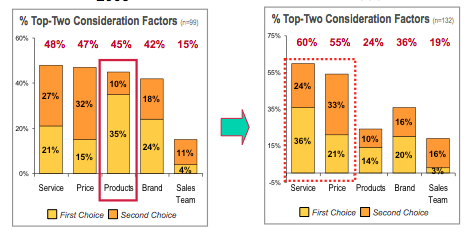
As a result, sales material and value proposition had to be updated quickly. Instead of espousing the virtues of innovation, it now needed to help buyers justify the investment. Leading to a shift from “bells and whistles” to “ROI models and product configurators.”
So, how do you communicate the impact marketing has on sales performance? Tell the sales folks that marketing can identify new buyers and influencers, increase the number of opportunities reps see, improve a buyers perception of sales coverage, and enable them with the right value proposition at the right time to win the deal. Of course, you’ll need the data to prove it.
In this case, the increased marketing investment and activities yielded $50 million in new sales over the two-year period…just as the model predicted.
by scott.gillum | Jan 21, 2013 | 2013, Marketing
Linkedin’s stock opened at $45 a year and a half ago, it now sits at $120. Unlike Facebook, one of the primary reasons it has done so well is that it found its’ “killer app”early on, and built a business model around it.
For recruiters, Linkedin is the largest (now 200 million members) and most current database of business professionals in the world. For job seekers, it’s a portal into new opportunities, connections and references.
To learn more about its capabilities as a recruiting tool, we posted an open account supervisor position for our DC office on Linkedin. The resumes have been sent directly to me for the past month. Unfiltered by a recruiter or HR person, I got a direct shot of the power of Linkedin. As the hiring manager, I learned a good deal about using the tool, and how job candidates can better marketing themselves for posted positions.
Because of the volume generated by Linkedin, hiring managers have the luxury of trying to find exactly what they are looking for without having to dig too hard to find it. We quickly scan the email summary and the attachments. As a result candidates need to:
- Read the job description – hiring and HR managers spend a great deal of time defining the role. Take the time to adapt your resume to highlight those areas that best match what we are looking for don’t make us connect the dots because we won’t…we’re already on to the next candidate.
- Customize your cover letter – tell us why you’re the right candidate for the position in the cover letter, especially if you can’t link it on your resume. Make a compelling case as to why we should spend additional time looking at your resume and background. A generic cover letter is a waste of time and a sure way to take yourself out of the race.
- Know that we will check you out – if we find someone we like, we’ll spend time checking your Linkedin profile (beyond the email summary below) our current and former employers, as well as your social profile. For example, a person that caught my attention was eliminated from the process because I couldn’t find their last two employers on the web. The learning – companies go out of business or are acquired all the time, make sure your resume reflects or notes that change. We will “Google” you.
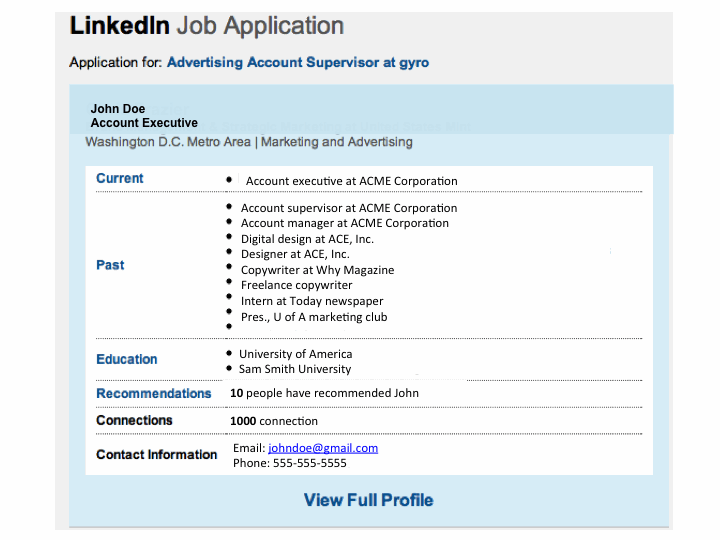
- Brands count – recruiting firms use key word searches to pull resumes. As for me, I scanned resumes also looking for those “key words.” Again, because of the need for speed certain words “pop.” Brand name companies caught my attention (whether the candidate worked for them or had them as a client). Schools you attended, the types of skills you have, and your accomplishments, especially if they were award winning. I also took notice of the number of Linkedin connections and references…it does matter, I’m looking for a good marketer.
- Using a connection/s works – leverage your Linkedin connections to find a common link to the hiring manager or job poster for an introduction. I trust the recommendations of people that I’ve worked with in the past. As a result, do your homework. The closer the connection to the hiring manager or recruiter the better chance it will get you noticed.
- What does not work – I found the executive education programs to be confusing. It took too much of my time to figure out if you graduated or only took a class. Consider moving the later under skills or experience rather than putting in education. I also found resumes that were more than 2 pages too long to read. A summary is a good to have upfront, but don’t go beyond more than a third of the page. Get into your experience quickly.
Talent is the lifeblood of an agency…for that matter most companies. What you think, say and produce grows our business. We need you, and we have jobs. Help make it easier for us to find you, link your experience and expertise to our needs. Hurry, I need someone…like yesterday.
 Partners, buyers of Cisco gear, selected Cisco for the strength of the relationship, despite that fact that Cisco was also the most profitable vendor (established earlier in the research). Cisco partners value the relationship more highly than other partners, 26% more.
Partners, buyers of Cisco gear, selected Cisco for the strength of the relationship, despite that fact that Cisco was also the most profitable vendor (established earlier in the research). Cisco partners value the relationship more highly than other partners, 26% more.
















